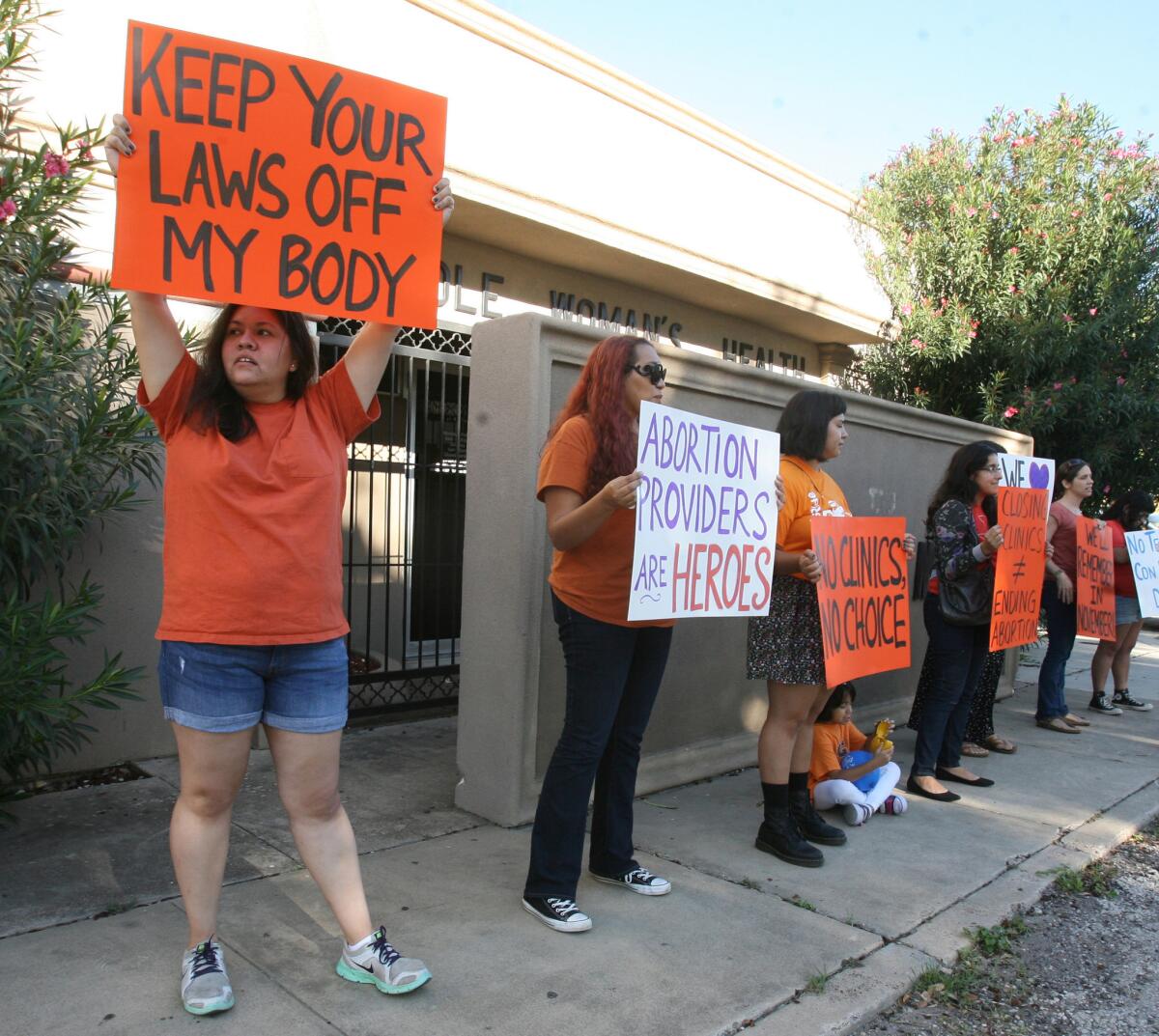Editorial:: Post-Scalia Supreme Court to rule on the most important abortion case in two decades

People protest in front of the Whole Women’s Health clinic on Oct. 4, 2014 in McAllen, Texas.
On Wednesday, the Supreme Court will consider arguments in the most important case it has heard on abortion rights in two decades. Whole Woman’s Health vs. Hellerstedt is a challenge by a group of abortion clinics to a 2013 Texas law that requires doctors providing abortions to have admitting privileges at nearby hospitals and directs abortion clinics to meet the safety standards of ambulatory surgical centers. These mandates, though they may at first sound reasonable, will in fact dramatically reduce the ability of Texas women to obtain abortions, and for no sound medical reason. The court should make it clear that this law — like hundreds of others enacted around the country — is an antiabortion measure that has been cynically passed off as a protection for women. The justices should side with the clinics and strike it down.
The court should see [this law] and others like it for what they are -- onerous restrictions masquerading as safeguards that are actually intended to curtail access to abortion.
Few legal rights are the subject of so much intense dispute as abortion. The Supreme Court first recognized a woman’s constitutional right to terminate a pregnancy 43 years ago in Roe vs. Wade. And in a 1992 case — Planned Parenthood vs. Casey — the court ruled further that the state could not place an “undue burden” on a woman seeking an abortion. But what constitutes an undue burden? Are there some restrictions or safeguards that are so important that they trump the inconveniences they create?
What the Supreme Court decides in the Texas case it hears this week will reverberate throughout the nation, where states have, in total, adopted 288 restrictions since 2010, according to the Guttmacher Institute, which researches and advocates for reproductive rights.
Since the portion of the Texas law requiring hospital admitting privileges for abortion providers went into effect, more than half of the state’s 41 abortion clinics have been forced to close. If the entire law is implemented, no more than 10 clinics will remain open, according to the Center for Reproductive Rights, which represents the clinics in the case.
Legislators in Texas and other states have repeatedly argued that these laws are intended to protect the health of women getting abortions. But the Texas plaintiffs — and the most respected medical organizations in the country — dispute this. They contend that legal abortions, without these restrictions, are among the safest medical procedures performed in the U.S. According to an amicus brief submitted by a group of medical organization that includes the American College of Obstetricians and Gynecologists and the American Medical Assn., the mortality rate for women having abortions in the U.S. was less than 1 per 100,000 between 2008 and 2011.
That is lower than the mortality rates for colonoscopies or liposuctions — and those procedures are not required to be performed in surgical centers. Further, say the physicians groups, the percentage of abortions that resulted in major complications was not higher for those performed in office-based clinics than those done in ambulatory surgical centers.
Nor is it necessary for physicians performing abortions to have hospital admitting privileges — which can be difficult to get no matter how competent the doctor is. If there are complications, patients can be seen in emergency rooms, the healthcare providers contend.
The question for the Supreme Court is whether these unnecessary regulations place substantial obstacles in the way of women seeking abortions in Texas. There are compelling arguments that they do: The law would leave some women in poor, rural parts of the state — the women with the least means to travel — hundreds of miles away from the nearest clinic. And with fewer clinics open, the patient load on each one will increase, forcing women to wait longer into their pregnancies for an appointment. Safe as abortion is, the mortality rate goes up from 0.4 per 100,000 in the first trimester to 1.7 per 100,000 if performed between 13 and 15 weeks and then up to 3.4 per 100,000 if performed between 16 and 20 weeks. Ironically, the law that Texas legislators says is intended to protect women sets up conditions that could make them less safe.
The court should see this Texas law and others like it for what they are — onerous restrictions masquerading as safeguards that are actually intended to curtail access to abortion. They don’t pass constitutional muster. If the court makes that clear enough, that ruling will help dismantle the array of laws in other states.
Follow the Opinion section on Twitter @latimesopinion and Facebook
More to Read
A cure for the common opinion
Get thought-provoking perspectives with our weekly newsletter.
You may occasionally receive promotional content from the Los Angeles Times.










